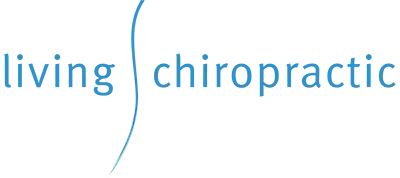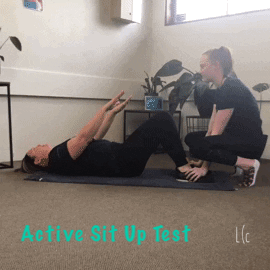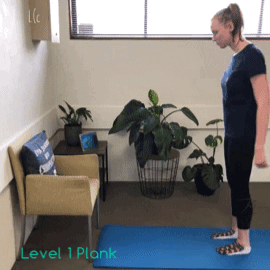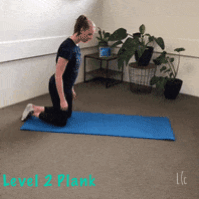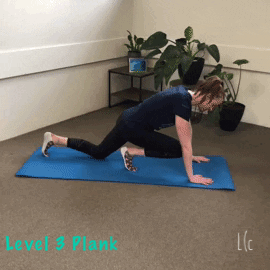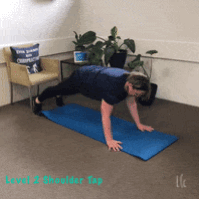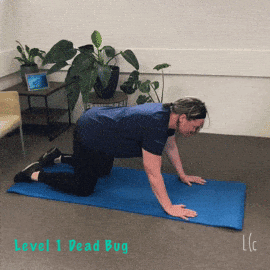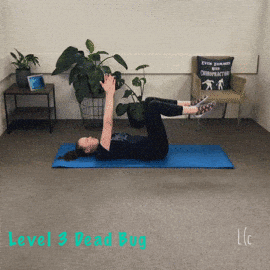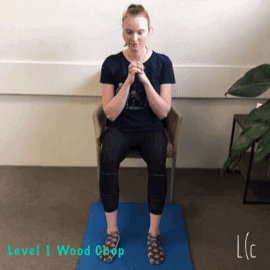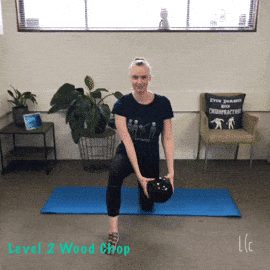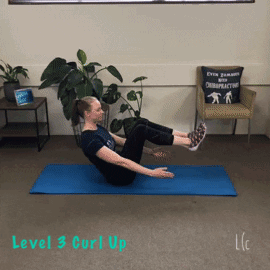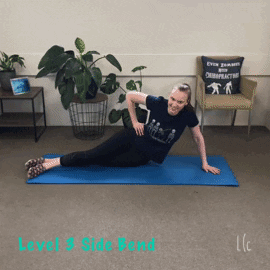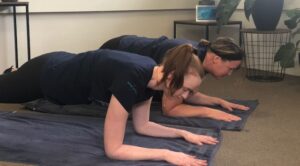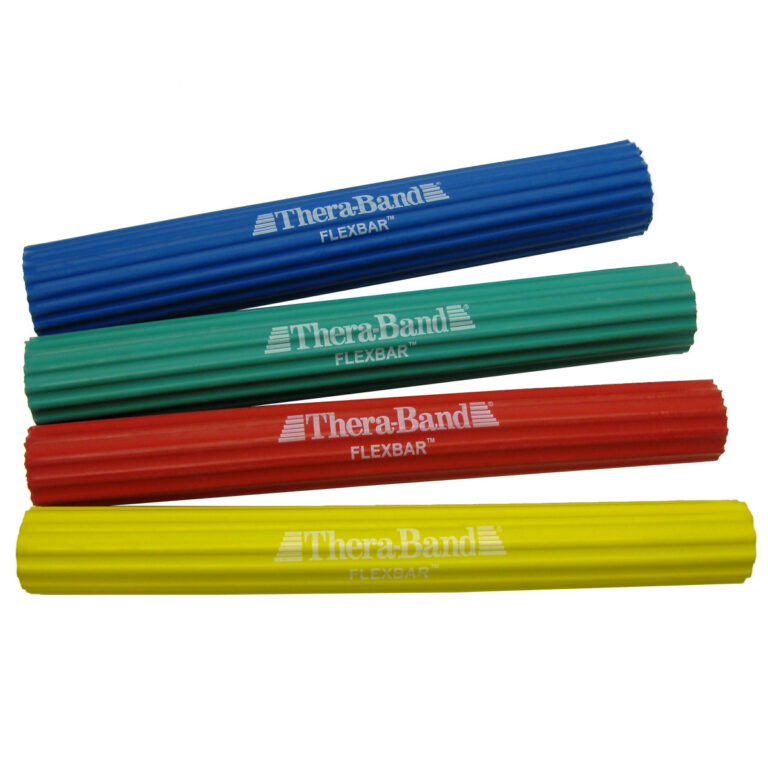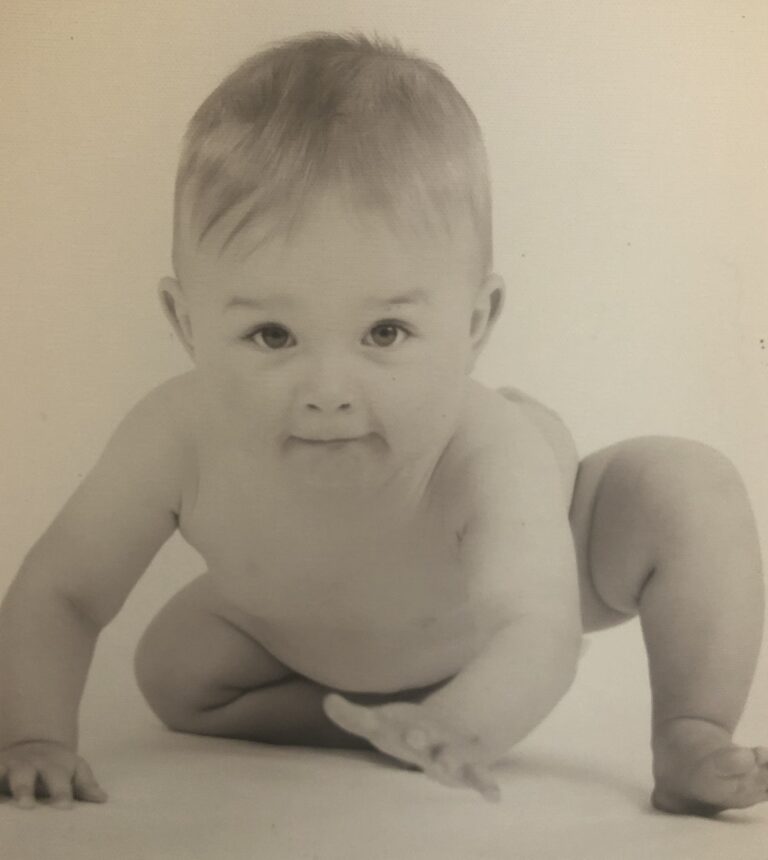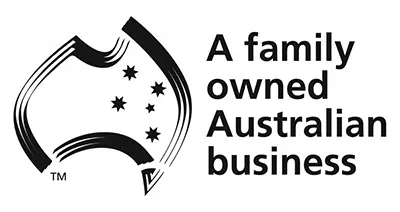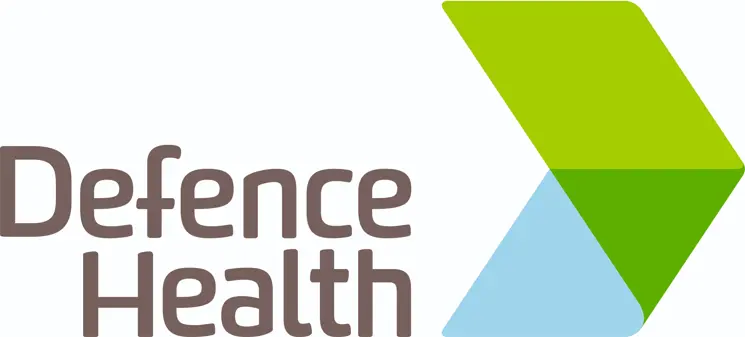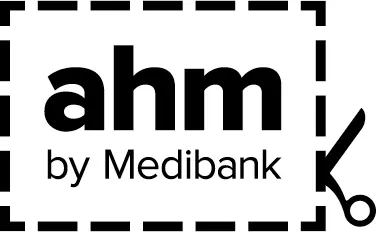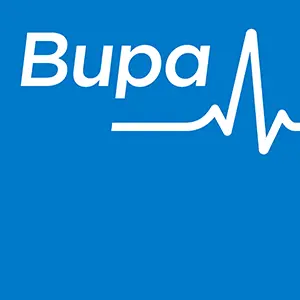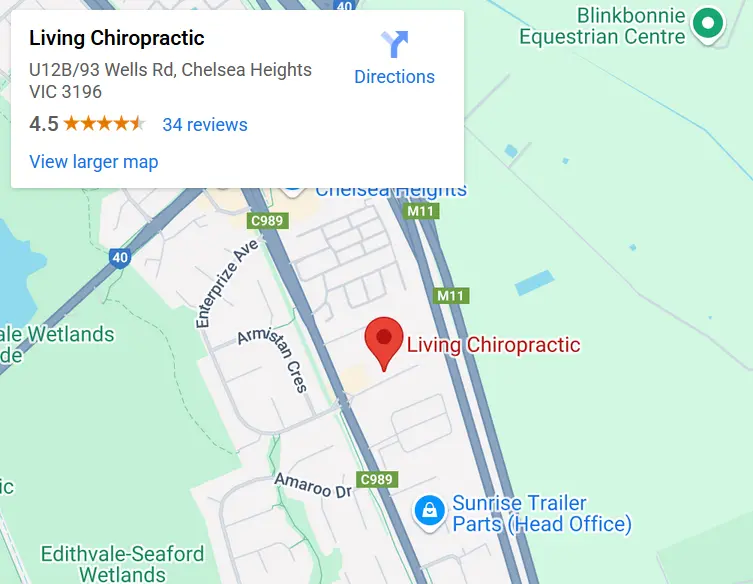ACTIVE SIT UP TEST
Not sure where your core is at?
Level 1: If you cannot hold it for 5 seconds then please talk to one of practitioners and                  do not advance past level one.
Level 2: Start here if you could hold it for 5 secs
Level 3: Start here if you can hold it for 2 minutes
 TOP 4 TIPS FOR GETTING STARTED
- If you suffer from lower back pain or have a herniated disc or any lower back pathology it is best to steer clear from sit-ups as it can aggravate your back pain.
- We have incorporated McGill’s abdominal exercises into our routine, if you have doubt consult one of our chiropractors or myotherapists for advice.
- We recommend that you don’t perform these exercises within 1 hour of getting up in the morning. After just 30 minutes of waking, your disc loses 54% and within 1 hour 90% of the normal daily loss of disc height and water content.
- We have provided 3 levels of exercises. Only progress to the next level if you can perform the other two levels easily.
Plank
How to do it:
Level 1:
- Press a chair against the wall to brace it.
- Place your hands onto the back of the chair
- Lean 45 degrees into it and keep your arms straight and extend your legs out.
- Squeeze your entire core, your glutes, and your quads, and tuck your butt under a little to keep your lower back straight. Make sure you are not dropping your hips or hiking your butt up high toward the ceiling
- Position your head so that your neck is in a neutral position and your gaze is on your hands.
- Hold up to 1 minute
Level 2:
- Extend your legs out behind you and place your knees on the ground. Lift your feet off the floor and cross them at the ankle. Your body should form one straight line from your shoulders to your knees.
- Squeeze your entire core, your glutes, and your quads, and tuck your butt under a little to keep your lower back straight. Make sure you are not dropping your hips or hiking your butt up high toward the ceiling.
- Position your head so that your neck is in a neutral position and your gaze is on your hands.
- Hold this position.
Level 3:
- Extend your legs out behind you and rest your toes on the floor. Your body should form one straight line from your shoulders to your heels.
- Squeeze your entire core, your glutes, and your quads, and tuck your butt under a little to keep your lower back straight. Make sure you are not dropping your hips or hiking your butt up high toward the ceiling.
- Position your head so that your neck is in a neutral position and your gaze is on your hands.
- Hold this position.
 Â
Panther Shoulder Tap
Level 1:
- Place a chair against a wall to brace it.
- Stand behind the chair, and hold on to the back for support.
- Lean the upper body forward 45 degrees and slowly raise one leg straight back behind you.
- Lift it as high as you can without bending your knee.
- Slowly lower your leg. Do 8–15 repetitions, and then repeat with the other leg.
- When you’re ready for more, add ankle weights. When you can do this comfortably, add a second set of repetitions.
Level 2:
- Start in a plank position
- Engage your core while keeping your back flat and your butt down.
- Position your head so that your neck is in a neutral position and your gaze is on your hands.
- Tap your right hand to your left shoulder, and then your left hand to your right shoulder, while using your core strength to keep your hips as still as you can.
Level 3:
- Start on all fours.
- Engage your core and while keeping your back flat and your butt down (like you’re in a plank), lift your knees off the floor about 1-3 inches. Gaze at the floor a few inches in front of your hands to keep your neck in a comfortable position.
- Tap your right hand to your left shoulder, and then your left hand to your right shoulder, while using your core strength to keep your hips as still as you can.
- Continue alternating sides.
Dead Bug
Level 1:
- Start on all fours.
- Engage your core and while keeping your back flat and your butt down (like you’re in a plank).
- Gaze at the floor a few inches in front of your hands to keep your neck in a comfortable position.
- Lift your right hand up, and then your left hand, while using your core strength to keep your hips as still as you can.
- Continue alternating sides.
Level 2:
- Lie face up with your arms extended toward the ceiling and your legs in a tabletop position (knees bent 90 degrees and stacked over your hips). This is starting position.
- Slowly extend your right leg out straight, while simultaneously dropping your left arm overhead. Squeeze your butt and keep your core engaged the entire time, lower back pressed into the floor.
- Stop extending your arm and leg once you can feel you lower back lifting.
- Bring your arm and leg back to the starting position.
- Repeat on the other side, extending your left leg and your right arm.
Level 3:
- Lie face up with your arms extended toward the ceiling and your legs in a tabletop position (knees bent 90 degrees and stacked over your hips). This is starting position.
- Slowly extend your right leg out straight, while simultaneously dropping your left arm overhead. Keep both a few inches from the ground. Squeeze your butt and keep your core engaged the entire time, lower back pressed into the floor.
- Bring your arm and leg back to the starting position.
- Repeat on the other side, extending your left leg and your right arm.
Half Kneeling Wood Chop
Level 1:
- Start by sitting on the chair.
- Engage your core and hold your hands together elbows down.
- Lift your left knee while you twist and tap your right elbow onto your left knee.
- Bring your arm and leg back to starting position
- Lift your right knee while you twist and tap your left elbow onto your right knee.
- Continue alternating sides.
Level 2:
- Start on your knees, and then step one leg a few feet in front of the other, foot flat on the floor and knee bent at 90 degrees. Hold a balloon by the knee that’s on the floor. Grasp onto both ends of the balloon. This is starting position.
- Bring the weight diagonally up toward the ceiling on the opposite side of your body, twisting your abs as you do. Keep your hips facing forward—only your core muscles should be rotating.
- Bring the balloon back down to starting position.
- Do all your reps on one side, and then repeat on the other side.
Level 3:
- Start on your knees, and then step one leg a few feet in front of the other, foot flat on the floor and knee bent at 90 degrees. Hold a light-to-medium dumbbell by the knee that’s on the floor. Grasp onto both ends of the weight. This is starting position.
- Bring the weight diagonally up toward the ceiling on the opposite side of your body, twisting your abs as you do. Keep your hips facing forward—only your core muscles should be rotating.
- Bring the weight back down to starting position.
- Do all your reps on one side, and then repeat on the other side.
High Boat to Low Boat
Level 1:
- Lower back pain or herniated disc – start here.
- Lie on your back with your knees bent, feet flat on the floor.
- Put your hands beneath the small of your back.
- Brace your core, flattening your low back hold for 8 secs.
- Aim for 8-15 repetitions.
- Rest and repeat the set.
Level 2:Â
- Lie on your back with your knees bent, feet flat on the floor.
- Put your hands out in front towards your knees.
- Brace your core, and raise your shoulders and head until your hands touch the top of your knees.
- Aim for 8-15 repetitions.
- Rest and repeat the set.
Level 3:Â
- Sit up straight with your legs bent, feet flat on the floor.
- Keeping your legs together, slowly lift them off the floor until they form a 45-degree angle to your torso. Engage your entire core, keep your back flat, and balance on your tailbone.
- You can keep your knees bent (as pictured) or straighten them out for more of a challenge.
- Reach your arms straight out in front of you, parallel to the floor. If you feel that you need some extra support, place your hands on the floor, underneath your hips.
- This is High Boat. Hold here for three deep breaths.
- Then, lower your legs, straightening them out, while also lowering your upper body. Both your shoulder blades and legs should hover a few inches off the floor. If that is too challenging, keep them slightly higher off the floor and work toward bringing them lower and lower.
- This is Low Boat. Hold for one breath, and then lift your legs and torso back to High Boat.
Side Bend
Level 1:
- Start by sitting on the chair.
- Engage your core and stand up out of the chair.
- Bend at your waist and reach down to your left knee with your left hand.
- Bring your arm and leg back to starting position and reach down to your right knee with your right hand.
- Sit down again.
- This is one rep.
Level 2:
- Start in a side plank with your right elbow on the floor, directly underneath your right shoulder, and your feet staggered so the left is right in front of the right (as shown). You can also stack your left foot on top of your right.
- Engage your core and your butt. Let your left arm relax by your left side.
- Dip your hips down toward the ground and then lift them back up. This is 1 rep.
- Do all your reps on one side, and then repeat on the other side.
Level 3:
- Start in a side plank with your right hand on the floor, directly underneath your right shoulder, and your feet staggered so the left is right in front of the right (as shown). You can also stack your left foot on top of your right.
- Engage your core and your butt. Let your left arm relax by your left side.
- Dip your hips down toward the ground and then lift them back up. This is 1 rep.
- Do all your reps on one side, and then repeat on the other side.
What is my “core�
Your core is more than your  abdominals and obliques.
As a chiropractor and myotherapist we have noticed that our patients cores were weakened after our last isolation stint. After the gyms opened especially the 2nd week we saw many injuries as a result of weakened core. We know that the deep layer of the core which holds the transversus abdominis, provides sensory feedback regarding movement. If this feedback isn’t switched on this can contribute to poor movement synchronicity.
The global layer of the core includes larger structures such as the obliques, glutes and rectus abdominis, which are involved in creating and controlling movement.
I like to think of the core as a house. The base of the house is the Pelvic Floor, if you don’t have a strong and stable base, the rest of your house becomes compromised. Every house needs walls, which are formed by the Rectus Abdominus, Obliques, Erector Spinae, Quadratus Lumborum and most importantly the Transverse Abdominus (TVA) which functions similarly to that of a belt for the core. The TVA holds a significant role in the core as it stabilises the Lumbar (lower back) and Pelvis before movement can occur. A house isn’t a house without a roof which is a role left for none other than the diaphragm, which highlights the importance of breathing whilst performing core exercises.
You will see in our exercises that they are not localised to your trunk. Your core involves control of movement of your entire body.
Why haven’t we included 100 sit-ups?
The problem with sit ups is the repeated lumbar flexion. Avoiding spinal flexion is not necessary for everyone; it really depends on how you spend your day. If you are an individual who stands all day or spends most of the day on your feet then flexion type exercises may not be so bad and may be encouraged. But this challenge begun because many of us are sitting more as a result of isolation.
f you are one of the many people sitting all day then you sitting in a flexed position. To add hundreds of sit ups, which is essentially more lumbar flexion before you know it you will have lower back issues.
Crunches and traditional sit-ups place 3,300 newtons the equivalent of 340 kg of compressive force on the spine when bent in flexion.  McGil also found that these forces can squeeze a bent disc’s nucleus to the point that it bulges – pressing on nerves and causing back pain, and potentially leading to a herniated disc. This is why five out of 6 of our exercises do not included sit-ups. Also we have included levels, from a very weakened core to those who want to go to the next level.
